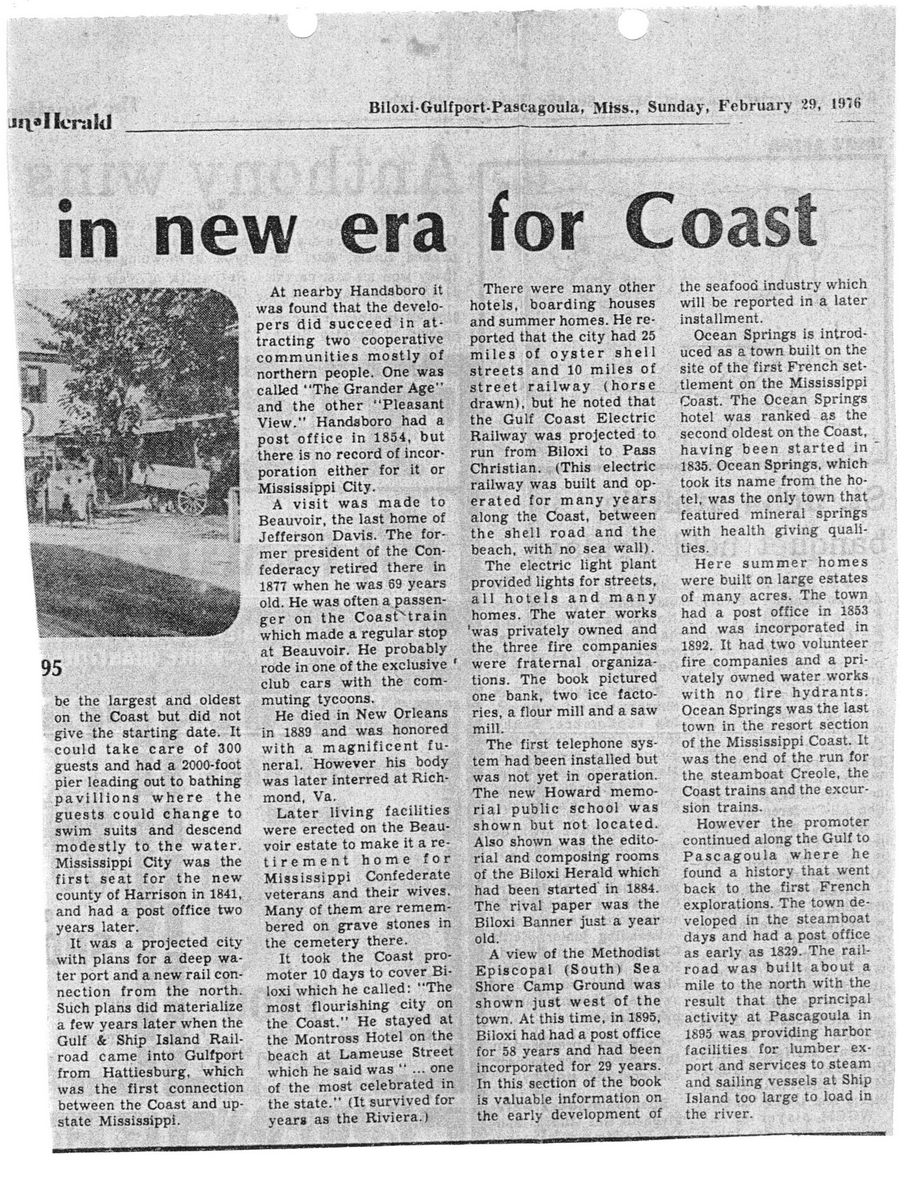This text was obtained via automated optical character recognition.
It has not been edited and may therefore contain several errors.
Jil* Herald Biloxi-Gulfport-Pascagoula, Miss., Sunday, February 29, UHfi in new era for Coas 95 be the largest and oldest on the Coast but did not give the starting date. It could take care of 300 guests and had a 2000-foot pier leading out to bathing pavillions where the guests could change to swim suits and descend modestly to the water. Mississippi City was the first seat for the new county of Harrison in 1841, and had a post office two years later. It was a projected city with plans for a deep water port and a new rail connection from the north. Such plans did materialize a few years later when the Gulf & Ship Island Railroad came into Gulfport from Hattiesburg, which was the first connection between the Coast and upstate Mississippi. At nearby Handsboro it was found that the developers did succeed in attracting two cooperative communities mostly of northern people. One was called ‘‘The Grander Age" and the other ‘‘Pleasant View.” Handsboro had a post office in 1854, but there is no record of incorporation either for it or Mississippi City. A visit was made to Beauvoir, the last home of Jefferson Davis. The former president of the Confederacy retired there in 1877 when he was 69 years old. He was often a passenger on the Coastxtrain which made a regular stop at Beauvoir. He probably rode in one of the exclusive ' club cars with the commuting tycoons. He died in New Orleans in 1889 and was honored with a magnificent funeral. However his body was later interred at Richmond, Va. Later living facilities were erected on the Beauvoir estate to make it a re-tirement home for Mississippi Confederate veterans and their wives. Many of them are remembered on grave stones in the cemetery there. It took the Coast promoter 10 days to cover Biloxi which he called: "The most flourishing city on the Coast.” He stayed at the Montross Hotel on the beach at Lameuse Street which he said was " ... one of the most celebrated in the state.” (It survived for years as the Riviera.) There were many other hotels, boarding houses and summer homes. He reported that the city had 25 miles of oyster shell streets and 10 miles of street railway (horse drawn), but he noted that the Gulf Coast Electric Railway was projected to run from Biloxi to Pass Christian. (This electric railway was built and operated for many years along the Coast, between the shell road and the beach, with no sea wall). The electric light plant provided lights for streets, all hotels and many homes. The water works 'was privately owned and the three fire companies were fraternal organizations. The book pictured one bank, two ice factories, a flour mill and a saw mill. The first telephone system had been installed but was not yet in operation. The new Howard memorial public school was shown but not located. Also shown was the editorial and composing rooms of the Biloxi Herald which had been started in 1884. The rival paper was the Biloxi Banner just a year old. A view of the Methodist Episcopal (South) Sea Shore Camp Ground was shown just west of the town. At this time, in 1895, Biloxi had had a post office for 58 years and had been incorporated for 29 years. In this section of the book is valuable information on the early development of the seafood industry which will be reported in a later installment. Ocean Springs is introduced as a town built on the site of the first French settlement on the Mississippi Coast. The Ocean Springs hotel was ranked as the second oldest on the Coast, having been started in 1835. Ocean Springs, which took its name from the hotel, was the only town that featured mineral springs with health giving qualities. Here summer homes were built on large estates of many acres. The town had a post office in 1853 and was incorporated in 1892. It had two volunteer fire companies and a privately owned water works with no fire hydrants. Ocean Springs was the last town in the resort section of the Mississippi Coast. It was the end of the run for the steamboat Creole, the Coast trains and the excursion trains. However the promoter continued along the Gulf to Pascagoula where he found a history that went back to the first French explorations. The town developed in the steamboat days and had a post office as early as 1829. The railroad was built about a mile to the north with the result that the principal activity at Pascagoula in 1895 was providing harbor facilities for lumber export and services to steam and sailing vessels at Ship Island too large to load in the river.

Hancock County History General Newspaper Clippings Railroad-Feb-1976-(3)